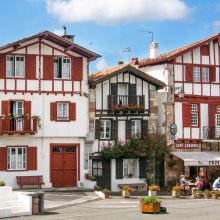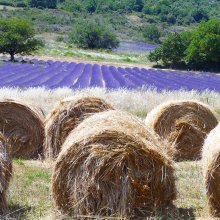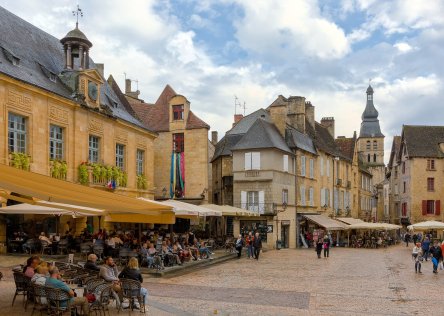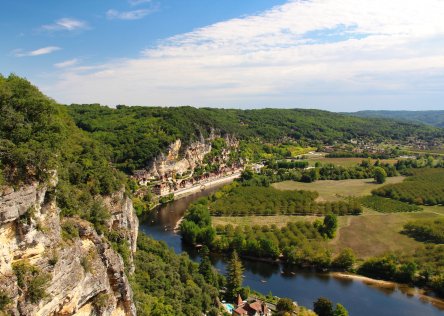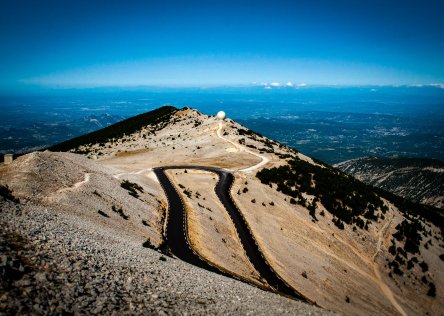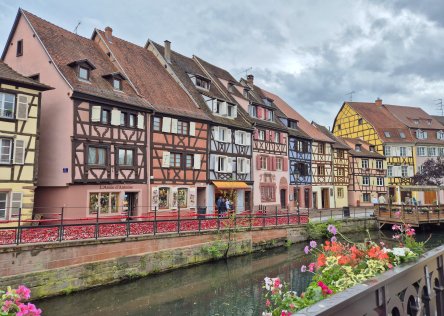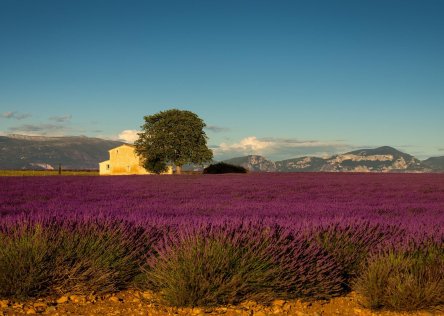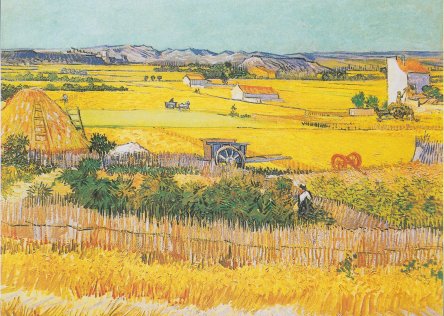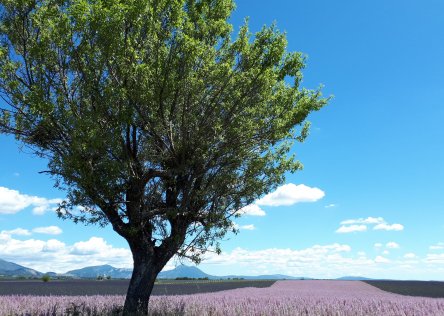The French Basque Country is one of southwestern France’s hidden gems, particularly as many travelers associate the Basque Country with Spain. In fact, the region spans the French-Spanish border.

From its Atlantic coastline to traditional mountain villages, we think a Basque Country road trip is the ideal way to explore, at your own pace.
You may enjoy outdoor activities like surfing or hiking, and you'll have plenty of opportunities to sample the region’s famous cuisine. We can also arrange for you to visit farms and rural areas where the food and wine is cultivated. Our Basque Country tours will help you to immerse yourself in this fascinating and deep-rooted culture.
This 5-day Basque Country road trip sample itinerary includes some of the highlights of the French Basque Country. We hope it inspires you to visit this region!
- Day 1: Arrival in Biarritz
- Day 2: Biarritz to Saint-Jean-de-Luz
- Day 3: La Rhune and Ainhoa
- Day 4: Espelette and Saint-Jean-Pied-de-Port
- Day 5: Bayonne and the End of Your Road Trip
- Best Time for a Basque Country Road Trip
- Final Tips
Day 1: Biarritz
Biarritz was a modest fishing village before it gained popularity in the 19th century when Empress Eugénie, wife of Napoleon III, chose it as her summer retreat. Since then, it has grown into a stylish coastal town known for its elegant villas, great surfing opportunities, and beach-side promenades.
-
Walk along the promenade at Grande Plage
The town’s main beach is very busy in the peak summer months. Enjoy a seaside stroll with views of the ocean and the historic Hôtel du Palais, which was originally the imperial family’s summer residence.
-
Visit the Rocher de la Vierge
This rocky outcrop, crowned by a statue of the Virgin Mary, is one of Biarritz’s most recognizable landmarks. A metal footbridge leads out to the rock. While there’s a local legend that says the bridge was designed by Gustave Eiffel (of Eiffel Tower fame), other sources argue it was actually built by the engineering firm Schryver and Cie d'Hautmont.
Either way, cross the bridge to the rock and enjoy stunning views of the Bay of Biscay and, on a clear day, the Pyrenees.
-
Explore Port des Pêcheurs
Unlike the grand seaside hotels, Port des Pêcheurs has a more modest, authentic feel. Napoleon III had the harbor built in the 19th century to support Biarritz’s fishing community. Nowadays, the old fishermen’s cottages house a handful of seafood restaurants - a lovely place to enjoy dinner with views of the boats and the ocean beyond.
If you’re visiting the nearby Musée de la Mer, there’s a scenic path that leads down to the harbor.
-
Walk along the Sentier du Littoral coastal path
If you have time, follow part of this coastal trail heading south toward Bidart. It’s an easy and scenic walk, perfect for taking in the dramatic coastline and ocean views.
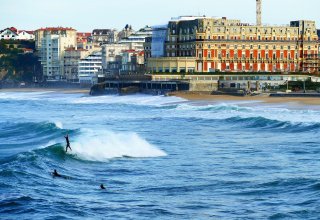
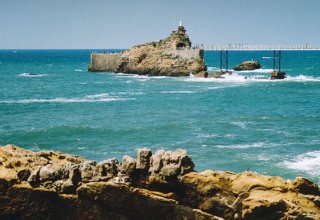
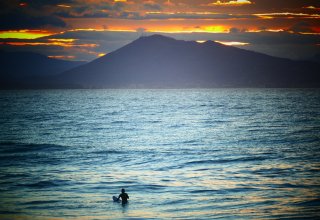
Day 2: Biarritz to Saint-Jean-de-Luz
Driving south along the coastal road toward Saint-Jean-de-Luz, you’ll enjoy the views over the lovely villages of Bidart and Guéthary.
Saint-Jean-de-Luz is a pretty harbor town near the Spanish border that is easy to navigate on foot and full of local character. It has a more laid-back pace than its neighbors along the coast and is a lovely place to spend the day.
-
Visit the picturesque harbor of Saint-Jean-de-Luz
Its fishing port is still active today, and it’s a great place for a stroll. You’ll see colorful boats bobbing in the water and traditional Basque houses with red or green shutters lining the quay.
-
Walk through Place Louis XIV
This main square is quite touristy in the high season, but nonetheless a nice place to stop for a coffee and soak up the atmosphere. It’s the heart of the town, and often filled with café tables and live music in the warmer months.
-
Visit the Saint-Jean-Baptiste Church
This is one of the most important churches in the region, and the site of a royal wedding. In 1660, King Louis XIV married Maria Theresa of Spain here, marking a key moment in French and Spanish history. Inside, you’ll see a beautiful wooden gallery and a decorated altarpiece typical of Basque religious architecture.
-
Try the macaroons at Maison Adam
A short walk from Louis XIV square, Maison Adam is an historic pâtisserie that has been making their famous Basque-style macaroons since 1660, originally created for the royal wedding. These are not to be confused with the colorful French macarons; they’re softer and almondy, and would make a nice authentic gift to bring back from your French Basque Country road trip.
-
Dine at a local restaurant
For a relaxed meal with seasonal Basque dishes, try a local restaurant like Toki Goxoa, a cozy spot near the harbor that’s popular with locals.
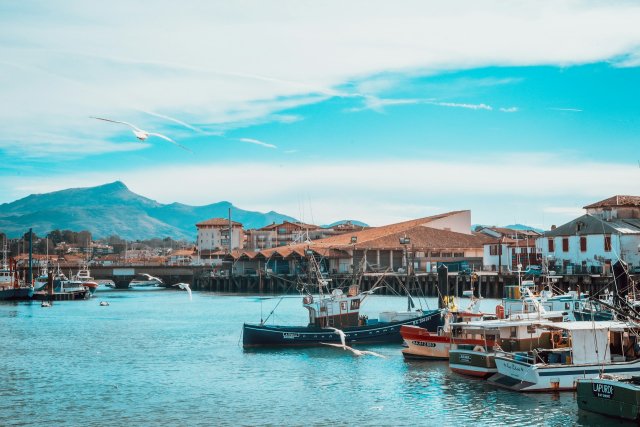
©
Day 3: La Rhune and Ainhoa
Today’s itinerary offers you a chance to enjoy this region’s beautiful mountains and the unique charm of a traditional Basque village.
-
A train ride up La Rhune
From early April through mid-November, you may take the vintage cogwheel train up La Rhune mountain. Starting from the Col de Saint-Ignace, near the village of Sare, this 35-minute journey climbs to nearly 900 meters and offers gorgeous views over the Atlantic coast and the Pyrenees. Be sure to bring a jacket, even on a warm day, as it will likely be cooler and windy at the top.
-
Watch for local wildlife
Along the way and at the summit, you may spot pottok ponies, a small, semi-wild Basque breed, as well as birds of prey like griffon vultures.
-
Drive to Ainhoa in the afternoon
On the way to Ainhoa, you may like to stop at the pretty village of Sare along the way. Then continue to Ainhoa, a traditional Basque village and officially among Les Plus Beaux Villages de France (The Most Beautiful Villages in France). The drive takes about 30 minutes and winds through peaceful countryside.
-
Stroll the village’s main street
We find Ainhoa charming because of its simple beauty, with rows of whitewashed houses with red or green half-timbering adorned with pretty flower boxes. It’s an ideal place to explore on foot, and stop for lunch or a drink.
-
Visit the village church and cemetery
You may be interested in visiting the village church to see its wooden galleries and impressive coffered ceiling. In the adjacent cemetery, you’ll see traditional Basque tombstones, many of them rounded and carved with unique symbols.
-
A scenic walk up to Chapelle Notre-Dame d’Aubépine
If you’re up for a scenic walk, follow the path about a mile up to the Chapelle Notre-Dame d’Aubépine. You’ll enjoy more of the gorgeous Basque countryside and will likely see some wild pottok ponies at the top.
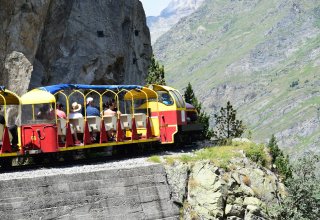
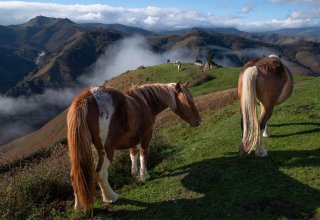
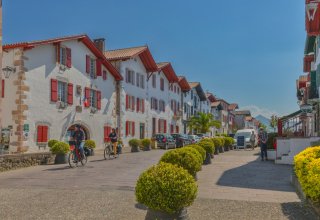
Day 4: Saint-Jean-Pied-de-Port and Espelette
Today you’ll visit two emblematic yet distinct Basque villages. One is known for its history and role on the Camino de Santiago pilgrimage; the other for a famous ingredient in traditional Basque cuisine.
-
Start in Espelette
This village is known for its AOP-certified red peppers, which are harvested and dried in the sun every fall. You may notice whitewashed houses decorated with strings of these peppers.
-
Stroll through the village center
Espelette is easy to explore on foot. As you walk through the main street, you’ll find little shops and local producers selling all kinds of pepper-based products, from spice blends and charcuterie to jams and chocolates. A nice opportunity to pick up an authentic souvenir from your Basque Country road trip!
-
Learn more about the Espelette pepper
If you’re interested in the cultivation process, you may like to visit L’Atelier du Piment, a family-run farm just outside the village where you can learn how the peppers are grown, dried, and prepared.
If you happen to be visiting in late October, the Espelette Pepper Festival takes over the town with local markets, music, parades, and tastings — a lively celebration of Basque food and culture.
-
Afternoon trip to Saint-Jean-Pied-de-Port
Nestled at the foot of the Pyrenees, this fortified town is a traditional starting point on the Camino de Santiago and has long welcomed pilgrims on their journey to Spain.
-
Walk along Rue de la Citadelle
Go for a wander along the main street, which is lined with stone houses, artisan shops, and cafés, in case you’re looking for souvenirs or want to stop for a coffee break.
-
Visit the old citadel
The short climb up to the Citadelle de Saint-Jean-Pied-de-Port offers views over the town and surrounding countryside. Originally built in the 17th century and later strengthened by Vauban, the citadel played a key defensive role due to the town’s location near the Spanish border.
-
Pass through La Porte de Saint-Jacques
This 15th-century city gate is part of the historic pilgrim route and is now listed as a UNESCO World Heritage Site. As you pass through it, think of the many travelers who have passed through it over the centuries before crossing into Spain!

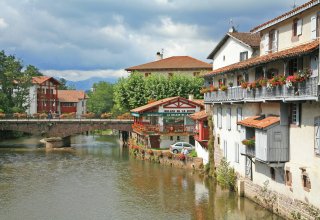
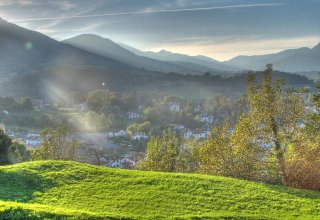
Day 5: Bayonne
Bayonne is a riverside town known for its half-timbered houses, chocolate shops, and artisanal ham. You may visit Bayonne on the last day of your Basque Country road trip, or you may visit earlier on, before or after Biarritz.
-
Visit Bayonne Cathedral and its cloisters
The Cathédrale Sainte-Marie is a Gothic landmark on the Camino de Santiago de Compostela pilgrimage route, and as such became a UNESCO World Heritage site in 1998. Its twin spires are visible across the city, and the peaceful cloisters are a quiet place to pause and sit down for a minute as you explore the city.
-
Browse the Halles de Bayonne
This covered market is a hub for regional produce and a good place to try some Bayonne ham, Basque cheeses, and other local specialties. Many locals shop here and there are also some cafes and restaurants if you want to stop for lunch or a snack.
-
Try the town’s chocolate
Bayonne is considered the birthplace of chocolate-making in France, introduced by Spanish and Portuguese Jewish settlers fleeing the Spanish Inquisition in the 16th and 17th centuries. Many chocolate shops still handcraft their products using traditional methods. It’s well worth stopping in to try a few.
-
Learn about local life at the Musée Basque
The Basque Museum in Bayonne is housed in a former merchant’s home, and gives visitors an insight into daily life, crafts, the Basque language, and other traditions that are unique to the Basque region. It’s one of the best places to get a fuller understanding of the culture you’ve experienced on your Basque Country road trip.
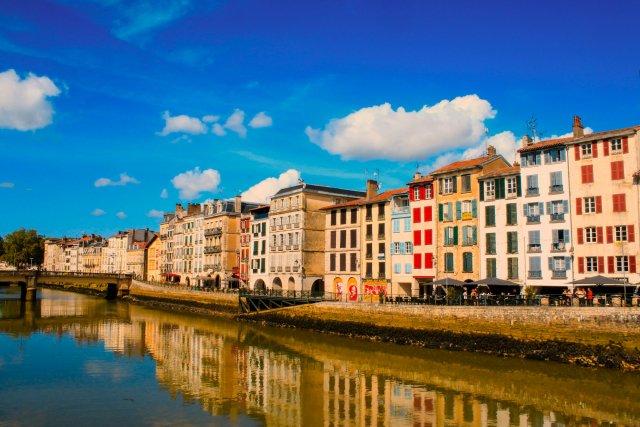
©
Unsplash CC0
Best Time for a Basque Country Road Trip
We recommend visiting the Basque Country in late spring or early fall, when the weather is generally mild and the atmosphere is more relaxed than the peak tourist season. These shoulder seasons are ideal for exploring the coast, hiking in the hills, and strolling through the region’s colorful villages without the crowds.
July and August are peak travel months. While there’s no shortage of summer festivals, the beaches will be busy, and traffic and parking can be challenging. The weather can be unpredictable, with both heatwaves and rainy spells.
In the cold (and often wet) winter months, it’s a good time to stay indoors and enjoy the local food scene, visit museums, or head to the Pyrenees for some skiing.
Final Tips
- Make the most of the freedom of a road trip, and allow time for spontaneous stops. Our France tour packages give you flexibility to spend more time in the places you love, and skip other places, if you wish.
- Be sure to try local culinary specialties like Bayonne ham, Basque cheesecake, and Ossau-Iraty cheese, with a glass of Irouleguy wine.
- Pack comfortable shoes for walking in historic towns and along coastal paths, and layered clothing, as the weather can be unpredictable and changeable, even in the summer months.
At France Just For You, we’ll listen to your wishes and preferences for your trip to France, and craft an itinerary that lets you explore confidently at your own pace by car. We’ll reserve charming B&Bs or boutique hotels that we have tested ourselves, recommend beautiful scenic driving routes and off-the-beaten-path hidden gems, and guide you to unforgettable experiences we think you’ll love.
Contact us today to start planning your perfect Basque Country road trip, or complete the trip planning form below!
Send us your France trip planning form
FAQ
How many days should I spend in the Basque Country?
We recommend spending at least 5 to 7 days in the Basque Country, especially if you would like to include a day or two in Spain too.
With a week, you’ll have time to explore the seaside towns of Biarritz and Saint-Jean-de-Luz, visit typical Basque villages like Ainhoa and Espelette, and enjoy scenic drives along the coast and into the foothills of the Pyrenees.
If you’d like to include time in the Spanish Basque Country too, just let us know when you contact us. We can extend your itinerary to suit your pace and interests.
What is the best season to visit Basque Country?
Spring (May–June) and fall (September–October) are the best time to visit the Basque Country. You’ll enjoy mild weather, fewer crowds, and a more relaxed pace than in the height of summer.
Spring is ideal for walking the coastal paths and exploring Basque villages in bloom, while fall brings warm days, beautiful harvest colors, and culinary festivals, including the Espelette Pepper Festival.
Summer (July–August) is the busiest time, especially along the coast, and the coastal roads. But if you want to book a summer tour, we will do our best to help you avoid the crowds with well-timed recommendations.
Winter is best suited to travelers interested in skiing in the Pyrenees or enjoying the region’s indoor attractions, like its excellent restaurants and museums.
Do I need a car in the Basque Country?
Yes — we believe a car is the best way to explore the French Basque Country. Many of the most beautiful spots are off-the-beaten-track in rural or coastal areas that are not easy (or impossible) to reach by public transport. Having your own car allows you to travel at your own pace, stop at scenic viewpoints, and discover charming villages and local markets that you might otherwise miss.
On our self-drive tours, we take care of car rental (automatic transmission available) and provide you with a personalized itinerary, maps, GPS directions, and support via our MyFrance app, so you can explore with confidence.
What are the best places to visit in the Basque Country?
We've mentioned many of the best places to visit in the Basque Country (on the French side) in this post. These include:
- Biarritz, with its elegant seaside promenade and Belle Époque charm
- Saint-Jean-de-Luz, known for its fishing port, historic church, and royal wedding connections
- Ainhoa and Espelette, two of the most picturesque Basque villages, each with its own character and traditions
- La Rhune, where a scenic mountain train offers panoramic views of the coast and Pyrenees
- Saint-Jean-Pied-de-Port, a medieval town on the Camino de Santiago pilgrimage route
- Bayonne, the chocolate and ham capital of the region, with a well-preserved old town and vibrant cultural scene
If you’re interested in visiting the Spanish Basque Country as well, we’ll be happy to build a custom itinerary that includes highlights like San Sebastián.
What are the most important driving rules Americans should know in France?
Most of our travelers are from North America. Key rules to keep in mind include priority to the right, roundabout etiquette, and speed limits (which are not always sign-posted). Understanding these basics makes driving in France for Americans, and international travelers in general, much more comfortable and enjoyable.


